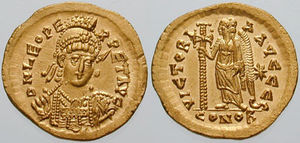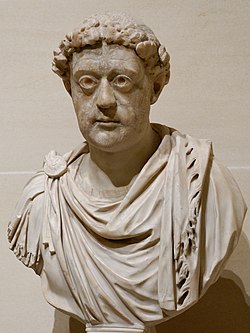Leo I (Byzantium)

Leo I , also Leon I ( ancient Greek Λέων Αʹ , called ὁ Μακέλλης ho Makelles "the butcher"; with full name Flavius Valerius Leo ; * around 401; † January 18, 474 in Constantinople ), was from February 7, 457 to on his death in 474, emperor of the late ancient Eastern Roman Empire .
Life
Flavius Valerius Leo evidently came from a very simple background and came from the diocese of Dacia . He spoke Latin and Greek and rose to become a troop leader; In 457, as comes et tribunus , he appears to have been the commander of one of the six legions that were stationed as a mobile elite force near Constantinople. After the death of Emperor Markian, he was promoted to Emperor ( Augustus ) at the instigation of the powerful magister militum (army master) Aspar . Aspar, who as an Arian could not become emperor himself, apparently assumed that he could easily control Leo, who had perhaps been the curator of his fortune for a while . Leo was acclaimed as emperor by senators and soldiers and then put on the shield. He was also possibly the first emperor whose subsequent coronation was carried out by a clerical dignitary - in this case by the Patriarch of Constantinople - (although it should be until 602 before the ceremony was no longer in the hippodrome or in the palace, but instead took place in a church).
Leo, who, unlike all his predecessors, had not even been part of the Theodosian-Valentine dynasty since 364, turned out to be an energetic ruler who did not lose sight of the tumbling west of the Roman Empire . In 467 he sent Anthemius , who himself had been traded as a possible emperor in 457, as the new Augustus of the West to Italy and provided him with a strong army and enormous financial resources. The reconquest of Africa , which was planned in cooperation with Westrom, failed miserably in 468 and was associated with an enormous financial bloodletting. When the emperor died six years later, the Eastern Roman treasury was almost exhausted, even though Leo had tried hard to increase income, which did not increase his popularity.

Contrary to what Aspar had expected, Leo soon proved to be a skilful power politician who increasingly emancipated himself from the dominance of the high military. In 462 his wife gave birth to a son, which seemed to settle the question of succession, but he died after a few months, and Aspar began to push for a marriage between his family and Leo. In order to ward off the increasing pressure from his army master, the emperor set up a new guard, the excubitores , in which many Isaurians served in addition to the Romans such as the later emperor Justinus . The Isaurians came from a remote region of Asia Minor and were considered half barbarians, but in contrast to the Alans and Goths, they were at least de iure members of the Roman Empire. Many of them have long served in the army. With the excubitores , the emperor now had his own armed detachment, which was only obliged to be personally loyal to him and not to the master. As a counterbalance to Aspar, Leo now also built up the future Emperor Zenon , whom he married to his daughter Ariadne . Aspar's son, the magister militum per Orientem Ardaburius, was accused of high treason by the emperor in front of the senate in 466/67 (Zenon had obtained the evidence) and deposed. Aspar, on the other hand, initially survived this conflict unscathed, which underlines its strong position.
The power struggle between the military and the emperor was not finally decided until a few years later: Although Aspar, who had meanwhile speculated on the throne for his other son Patricius , still succeeded in elevating him to Caesar in 470 , but in the following year he and Ardaburius became von Leo's men slain during an audience in the palace. It is said that the father and son were then dismembered to be carried out of the palace unnoticed. Patricius seems to have survived injured, as does Aspar's third son Ermanerich, who was not in Constantinople at the time in question.
Because of this act, which was an open breach of the law, Leo was nicknamed Makélles ("butcher") by the contemporary historians Malchus of Philadelphia and Candidus . Aspar's follower, the comes Ostrys, then undertook an attack on the palace with some Germanic foederati who were staying in Constantinople, but the excubitores were able to repel it. Leo then allegedly recommended his Western Roman imperial colleague Anthemius to deal with his master Ricimer in the same way as he himself had done with Aspar. In Italy, however, the conflict between the emperor and the military turned out differently and ended in 472 with the execution of Anthemius.
The threat from the Huns was minimal. Attila's sons Ernak and Dengizich tried to get contracts with Ostrom, but Leo used his stronger negotiating position and turned them down. Dengizich fell in 469 fighting against Eastern Roman troops. With the Goths in Pannonia , Leo initially came to an equalization, especially since Alane Aspar had favored the Goths. The young Theodoric stayed as a hostage at the imperial court from around 459 to 469. The murder of Aspar, however, strained Leo's relationship with the Goths, whose pressure on the Balkan provinces increased: Ostrys had fled to Theoderich Strabo and incited him against the emperor. Only in 473 could this conflict be resolved for the time being, when Strabo was appointed magister militum praesentalis and recognized as the king of his Goths. In the west, after Anthemius ' death , Leo apparently installed Olybrius and then Julius Nepos as the new emperor. However, these could no longer achieve a stabilization of the West, although Leo at least had equipped Nepos with an army despite empty coffers. One year after Leo's death, Nepos had to flee Italy, and in 476 the Western Roman Empire was effectively extinguished. With the Sassanids in the east under Leo, however, peace could be kept despite tensions around 468, which significantly relieved the empire militarily. Leo's successor was for a short time his grandson Leo II , the son of Zenon, and after his early death Zenon himself.
There is evidence that around 460 the Eastern Romans tried to establish closer relations with China, where several gold coins minted under Theodosius II and Leo can be found. Leo's legacy also included a large forum , which today has virtually disappeared without a trace , which he had built in Constantinople in 471 in the tradition of the Roman imperial forums; his predecessors Arcadius , Theodosius II and Markian had proceeded in the same way, but after Leo this series was broken off. In the center of the forum stood a pillar that celebrated the emperor's victories and which was not overturned until the 15th century.
reception
Tradition preserves a contradicting image of the emperor, who was on the one hand a successful and a friend of education, but on the other hand a greedy tyrant who plundered aristocrats and cities:
"Leo, Emperor of the Romans, called" the butcher ". He seemed happier than the emperors before him, but at the same time he was feared by all who lived under his rule, especially by all the barbarians who had heard of him. At least that is the reputation he enjoyed among the common people. But Malchus writes: “I do not think it is luck when someone deprives his subjects of their wealth, pays traitors to accuse them, and reproaches himself when he cannot find anyone to do it for him, and heaps of gold hoards from all parts of the world just to be rich himself, while at the same time robbing the cities of their previous prosperity and surplus, so that they can barely pay the taxes he demands. In short, ”continues Malchus,“ he was a refuge for every villain. ”In any case, it was Leo, the Hyperechius, the grammarian, banished. But once, when he ordered the philosopher Eulogius to be given a grant for lifelong subsistence, one of the court eunuchs said that the money should be better spent on soldiers, and Leo replied: “I wish it would happen in my lifetime all money could be used for teachers instead of soldiers. ""
literature
Overview representations
- Andreas Külzer : Leo I. (Kaiser). In: Real Lexicon for Antiquity and Christianity . Volume 22, Hiersemann, Stuttgart 2008, ISBN 978-3-7772-0825-1 , Sp. 1177-1188
- Eckhard Wirbelauer : Leo I., 457–474 . In: Manfred Clauss (Ed.): The Roman Emperors. Munich 1997, pp. 406-411.
Investigations
- Brian Croke: Dynasty and Ethnicity. Emperor Leo I. and the Eclipse of Aspar. In: Chiron . Volume 35, 2005, pp. 147-203.
- Ken R. Dark, Anthea L. Harris: The Last Roman Forum. The Forum of Leo in fifth-century Constantinople . In: Greek, Roman and Byzantine Studies . Volume 48, 2008, pp. 57-69.
- Stephen Mitchell: A History of the Later Roman Empire. Oxford 2007.
- Gereon Siebigs: Emperor Leo I. The Eastern Roman Empire in the first three years of his reign (457–460 AD). Berlin / New York 2010, ISBN 978-3-11-022584-6
- Michael E. Stewart: The First Byzantine Emperor? Leo I, Aspar and Challenges of Power and Romanitas in Fifth-Century Byzantium . In: Porphyra . Volume 22, 2014, pp. 4-17.
- Philip Wood: Multiple Voices in Chronicle Sources. The Reign of Leo I (457-474) in Book Fourteen of Malalas. In: Journal of Late Antiquity . Volume 4, 2011, pp. 298-314.
Web links
- Hugh Elton: Short biography (English) at De Imperatoribus Romanis (with references).
Remarks
- ↑ Prokop , Historien 3,6,1-24.
- ^ On the events of Henning Börm, rulers and elites in late antiquity , in: Josef Wiesehöfer et al. (Ed.), Commutatio et contentio. Studies in the Late Roman, Sasanian, and early Islamic Near East , Düsseldorf 2010, pp. 159–198.
- ↑ Suda , keyword Cheirizô ( Χειρίζω ), Adler number: Chi 245 , Suda-Online
- ↑ Derived from the Latin word macellarius ("butcher").
- ↑ John Malalas 14.40.
- ↑ John Malalas 14:45.
- ↑ Cf. Gereon Siebigs: Kaiser Leo I. Berlin / New York 2010, p. 497f.
- ↑ Suda Lambda 267 ( online ).
| predecessor | Office | successor |
|---|---|---|
| Markian |
Eastern Roman Emperor 457–474 |
Leo II |
| personal data | |
|---|---|
| SURNAME | Leo I. |
| ALTERNATIVE NAMES | Leon I. |
| BRIEF DESCRIPTION | Emperor of the Eastern Roman Empire |
| DATE OF BIRTH | at 401 |
| DATE OF DEATH | January 18, 474 |
| Place of death | Constantinople |